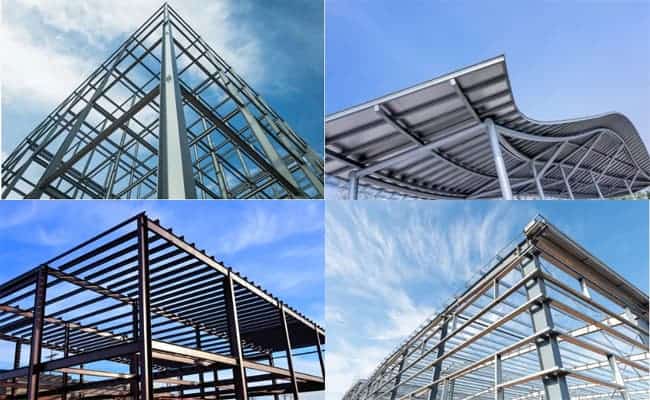Building Steel Structure: 10 Type Classification
There are many ways to classify building steel structures. According to the structure type, they are portal frame, steel frame, truss, grid, lattice shell, tower, cable-membrane structure, steel-concrete structure, etc. However, in actual projects, they are often classified according to the project’s classification of uses.
Building steel structure classification
1. Building steel structure: Factory buildings
Portal frames are often used, and some also use a combination of concrete columns + steel roof trusses (single-piece trusses or steel beams).
It is characterized by a large span, low steel content, and fast construction speed, and it can be equipped with mezzanines or crane beams according to different usage requirements, making it suitable for factory use.
2. Commercial and residential Structure
The primary structure mainly uses steel frames, and multi-story structures use H-shaped steel columns, some with inter-column supports; high-rise or long-span structures mostly use rectangular, round tubes and combined sections as steel columns. Part or all of it is a steel-concrete structure. It is characterized by a flexible bay layout, good structural stability (small deformation), and good load-bearing capacity, making it suitable for commercial and residential use.
3. Industrial frames:
The primary structure mainly uses steel frames, some of which are integrated with equipment. They are generally equipped with inter-column and horizontal bracing, including equipment bracing, monorail cranes, pattern plates, steel ladders, etc.
It is characterized by primarily mechanical equipment brackets or structures, with staggered structures and numerous cross-section mutations, which facilitate the support and maintenance of process equipment. It is suitable for enterprises with large equipment, such as power plants, chemical plants, steel plants, and offshore platforms.
4. Building Steel Structure for the Venue:
The main structure is mostly a hybrid structure, generally including steel frames, trusses, grids, reticulated shells, steel-concrete structures, string beam structures, spiral staircases, hyperbolic beams, etc.; typically, it contains curved surface shapes, including curtain walls, metal roofing, and other enclosure structures.
It has a relatively unique shape, high recognition, and a good connection between various internal functional areas. It suits multiple venues, transportation stations, science and technology, cultural research centers, and other landmark buildings.
5. Bridges
The main structures are mostly suspension bridges, cable bridges, truss bridges, box bridges, etc., generally curved in the height or horizontal direction. They are characterized by large spans, beautiful structures, a high degree of factory prefabrication, and fast on-site construction. They suit road traffic crossing rivers, valleys, bays, and other natural chasms or line intersections.
6. Trestle bridges and corridors:
The main structures are trusses or steel frame beams, generally equipped with inter-column and horizontal supports.
Generally, one end of the span direction is set as a sliding hinge support, or a transfer station is set up at a certain distance to release temperature stress structures. The characteristics are that the lines are generally long, overhead, continuous, and have a large span. They are suitable for various scenarios requiring overhead transportation or traffic.
7. Canopies
The main structures are mostly tube trusses, special-shaped steel frames, membrane structures, grids, etc. They are generally open structures, and the steel columns are mostly rigid cantilever columns, usually with curved surface shapes. The characteristic is that the ample lower space does not block the line of sight, and the shape is beautiful. Suitable for use in stadium stands, pedestrian streets, station platforms, and other scenes.
8. Tower Structure:
The main structures are towers, steel tubes, concrete tubes, and generally high-rise structures. The characteristics are that most of the tower rods are bolted, and the construction period is short. Cantilever beams mainly support the external structure of the chimney and require welding, making the construction complex.
Standard towers include transmission towers, monitoring towers, and landscape towers. Common chimney steel structures include inner and outer platforms and stairs.
9. Lighting roof type
The main structure is primarily a grid, lattice shell, supported beam, etc. It is generally a convex steel roof that considers drainage. Both beauty and lighting effects characterize it. It is suitable for use in scenes such as large shopping malls, venues, stations, and other large internal spaces to supplement natural lighting.
10. Scattered steel components:
The main structure is primarily a single truss, cantilever beam, or cantilever column, which generally belongs to the secondary structure. It is suitable for pipe supports, hangers, cable trays, maintenance platforms, etc.
In conclusion
Building steel structures has developed rapidly, and project management levels have significantly improved. Project managers have increasingly higher requirements for material procurement control, construction process control, construction period control, construction accuracy control, and construction safety control;
The factory production of components requires precise installation and processing drawings; the market procurement and logistics transportation of materials require an accurate bill of materials.
The post Building Steel Structure: 10 Type Classification appeared first on Havit Steel in design and fabricated Metal Buildings in China.

